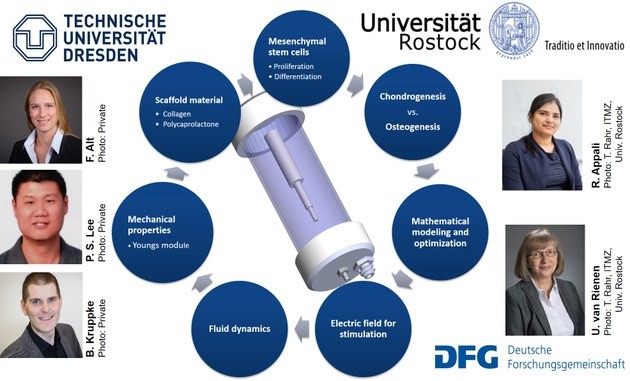Investigating the synergistic effects of spatially resolved biochemical, physicochemical, and physical key stimuli to generate biomimetic niches in perfusion bioreactor and their proficiency to derive large bone-like constructs.
Bioreactors are used increasingly in bone tissue engineering approaches, but the existing homogenous niche applied is generally insufficient to achieve/support formation of bone-like constructs. In physiology, multiple osteochondral cells are present in high cell density and their dynamic interactions are critical for bone development and regeneration processes. This is also complemented with supporting parameters such as oxygen tension (pO2) distribution, biochemical stimuli, and physical/mechanical stimuli to establish the dynamic niches essential for the growth of naïve organs (i.e. cartilage and bone) and attaining their functionalities. In this proposal, we aim to investigate the synergistic potentials of 5 distinct parameters to recapitulate bone developmental processes in a perfusion bioreactor. Through the established dynamic biomimetic niches, the effects on construct development and capability to achieve bone-like tissues in vitro will be assessed. These parameters include 1) medium pH; 2) pO2; 3) Young´s modulus of 3D-printed scaffolds; 4) multi-step osteochondral differentiation regimes and 5) Transformer-like induced electric field (TLC-EF) stimulation to emulate piezoelectric stimuli during movement. Human bone marrow-derived mesenchymal stem cells (hMSC) and human induced pluripotent stem cells (hiPSC) will be used to define the proficiency of biomimetic niches. Their potential to derive different osteochondral cell-types in the biomimetic niches will be critically assessed. Specifically for TLC-EF stimulations, multiscale modelling/simulations that describe EF/Bone construct interactions and the effects on osteogenesis will be combined with experimental validations. This is done with the aim to define an effective range of EF parameters for bone tissue engineering applications. Ultimately, this study will result in a specific set of conditions/stimuli that can recapitulate physiological-like niches in vitro. The approaches applied will also introduce a novel concept to the field of tissue engineering and can be further exploited to derive bone-like constructs with near-physiological properties in a bioreactor.
Project duration
3 years (from 07/2021)
Team involved
Principal Investigators: Prof. Dr. Ursula van Rienen, Dr.-Ing. Poh Soo Lee, Dr.-Ing. Benjamin Kruppke
Team involved: Post-doctoral researcher (Uni Rostock), Dr.-Ing. Revathi Appali
TU Dresden: Dr.-Ing. Poh Soo Lee (Eigene Stelle), PhD Student: Dipl.-Ing. Franziska Alt – supervised by Dr.-Ing. Benjamin Kruppke


